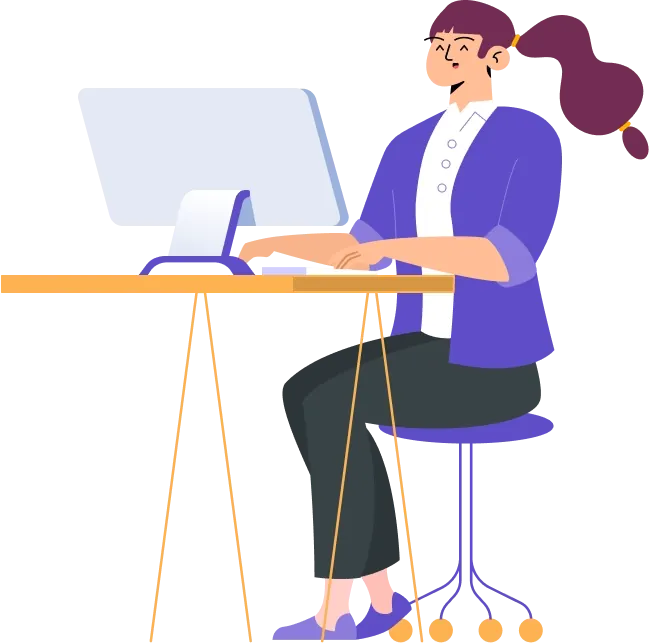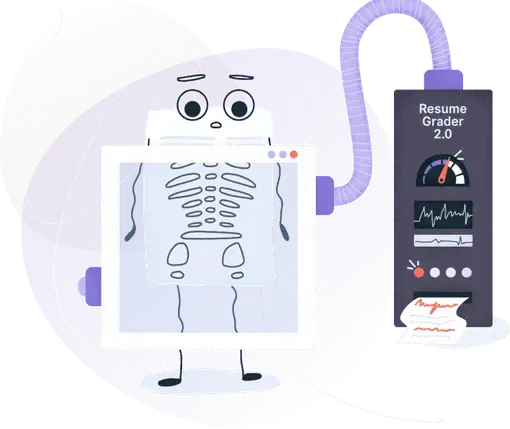Multitasking Skills on a Resume: A Complete Guide for 2025
Here are the top ways to show your multi-tasking skills on your resume. Find out relevant multi-tasking keywords and phrases and build your resume today.


Is your resume ATS-friendly?
Drop your resume here or upload a file to find out if the skills in your resume are readable by an ATS.
Imagine you're at the airport, managing your boarding pass on your phone, keeping an eye on the flight schedule, sipping your coffee, and having a quick chat with a fellow traveler. All these things happen at once, but somehow you’ve got it covered.
Now, apply that skill to the workplace. You’re attending a virtual meeting, reviewing a project report, and responding to client emails all at once. If you can keep everything running smoothly, you’re a multitasking pro at work!
We’ll walk you through how to present your multitasking abilities so your resume gets the attention it deserves in a competitive field.
First, let’s go over the most important points from this article.
Key takeaways
- Balancing responsibilities and shifting priorities is essential for your success in fast-paced environments.
- Quantifying multitasking skills makes them more impactful, showing how effectively you can manage multiple tasks with measurable outcomes.
- Using action verbs like "managed" or "coordinated" helps illustrate your abilities in a more engaging way.
- Highlight multitasking in multiple resume sections, like your personal statement, experience, and achievements, for maximum visibility.
- Know when to multitask and when to focus on a single task, demonstrating that you can balance both approaches to avoid errors.
- Be honest about your abilities and provide realistic examples, as overstating skills can lead to missed opportunities.
Now, let’s review the key multitasking skills that can make your resume more appealing.
What are multitasking skills for a resume?
Multitasking means being able to handle several things at once and still get them done efficiently and accurately. These balancing skills range from organizing your workflow and taking care of several emails at once, to more advanced capabilities such as handling multiple projects, meeting tight deadlines, and quickly shifting priorities.
Multitasking is valued in many industries, especially in fast-paced environments where employees are expected to handle competing demands. Including multitasking skills shows potential employers you can stay organized, adapt quickly, and maintain productivity under pressure. All these qualities are highly desirable in today’s dynamic workspaces.
Multitasking during lunch breaks
According to a study by ezCater, workers are 40% more likely to skip lunch now (2024) than just a year ago. Nearly 48% of employees report skipping lunch at least once a week. This trend is particularly strong among Gen Z workers, with 70% skipping lunch weekly due to fears of being judged by their bosses for taking a break.
Furthermore, one in five workers say they have too many meetings to take a proper lunch break, leading to multitasking, such as eating during video calls. Despite 83% of workers considering it bad etiquette to eat on external calls and 74% on internal ones, 30% still do it. This behavior not only disrupts workplace norms but also contributes to long-term burnout and decreased productivity.
When to put multitasking skills on a resume
You should add multitasking skills to your resume when they’re a part of the job offer you're applying to. Many positions, especially in fast-paced environments, appreciate multitasking because it shows you can handle multiple responsibilities at once.
If the job involves managing several tasks, working under tight deadlines, or balancing competing priorities emphasizing your multitasking abilities can boost your application.
PRO TIP
Use strong action verbs like "coordinated," "managed," or "streamlined" to bring your multitasking skills to life on your resume. Action verbs paint a clear picture of how you successfully balance responsibilities, helping potential employers visualize your abilities in action.
Now that you know when to include multitasking, let’s talk about how to highlight this skill on your resume.
How to list multitasking skills on a resume
Use these tips to present your multitasking capabilities on a resume:
- Don’t just list "Multitasking" as a skill. Provide examples like "Simultaneously managed project timelines, client communications, and team schedules."
- Write multitasking examples that show tangible results. For instance, "Managed numerous marketing campaigns simultaneously, leading to a 25% increase in engagement."
- Tailor your multitasking skills to the job description. If the role requires handling multiple clients, highlight experiences where you successfully juggled client communications, feedback, and project deadlines.
- Don’t exaggerate your multitasking skills or lie on your resume. It can hurt your chances of getting the job.
- It’s also important not to take on more than you can manage, as this can lead to burnout. Instead, give realistic examples of how you handle many tasks effectively.
- If you’ve used tools or software to enhance your multitasking, such as project management platforms like Trello or Asana, list those to further support your skills.
To see how it all works, here’s a sample resume for reference.
Multitasking skills in a resume sample
Take a look at Sarah Mitchell’s project manager resume for inspiration. If you need a starting point, our free template is a great option.
Use Enhancv’s AI-powered resume builder to easily customize it to your style.
Sarah Mitchell
Project Manager
(512) 555-9876 | s.mitchell@enhancv.com | @LinkedIn | Boston, MA
Summary
Results-driven Project Manager with 7+ years of experience in managing cross-functional teams, overseeing budgets, and multitasking across numerous projects to ensure timely delivery within scope. Skilled in using project management tools like Trello and Asana to streamline workflows and improve team efficiency. Proven ability to handle competing priorities while driving successful project outcomes and fostering team collaboration.
Experience
Senior Project Manager
Tech Solutions, Boston, MA
March 2020 – Present
- Led project teams through the entire lifecycle, multitasking across various projects while ensuring deadlines were met.
- Utilized Asana and Trello for task management and progress tracking, improving project completion rates by 30%.
- Collaborated with stakeholders to define scope, budgets, and timelines, successfully delivering 95% of projects on time and within budget.
- Implemented a resource management system that reduced overall project delays by 20%, while juggling many high-priority tasks simultaneously.
Project Manager
Bright Ideas Consulting, Boston, MA
May 2017 – February 2020
- Managed multiple client projects at once, multitasking to ensure clear communication and timely deliverables across teams.
- Coordinated between departments, aligning goals and improving team productivity by 25%.
- Introduced Agile methodologies, which shortened project timelines by 15%, while simultaneously managing multiple deadlines and client feedback.
Education
Bachelor of Science in Business Administration
University of Massachusetts, Boston, MA
May 2017
Certifications
- Project Management Professional (PMP) (2021)
- Certified ScrumMaster (CSM) (2020)
Skills
- Project Management Tools: Trello, Asana, MS Project
- Multitasking and Prioritization
- Budgeting and Resource Allocation
- Agile and Scrum Methodologies
- Risk Management
- Stakeholder Communication
- Timeline and Task Coordination
Languages
- English (Native)
- French (Working proficiency)
Maximize your multitasking skills by running your resume through Enhancv’s checker for ATS optimization.
Is your resume good enough?
Drop your resume here or choose a file. PDF & DOCX only. Max 2MB file size.
Let’s go over how to place these skills in a way that makes the biggest impression.
Where to put multitasking skills on a resume
Your multitasking skills can be a strong asset on your resume. You can integrate them into any of these sections:
- Personal statement
- Work Experience section
- Educational section
- Certifications
- Achievements
As you read on, keep this quote in mind.
The brain is not designed to multitask. When people think they're multitasking, they're actually just switching from one task to another very rapidly.
John Medina
Let’s take a closer look and explore some real resume examples.
How to present multitasking skills in the summary
To feature multitasking skills in your resume summary, emphasize how they help you meet deadlines. Focus on showing your ability to manage various responsibilities at once, ensuring timely results.
Highlight how these skills make you well-suited for dynamic, fast-paced roles where managing priorities is essential.
How to present multitasking skills in the experience section
When presenting multitasking competencies in the experience section of your resume, tailor your resume description to reflect how these skills directly contributed to the success of a project or team.
It’ll be useful to link your multitasking ability to related skills, like organization or problem-solving, to demonstrate that you’re not just handling multiple tasks but doing so effectively. This approach will give potential employers a more comprehensive view of how your multitasking adds value.
- •Handled up to 50 customer inquiries daily across phone, email, and chat, resolving issues efficiently.
- •Multitasked between communication channels while maintaining a 95% customer satisfaction rating.
- •Collaborated with technical teams to troubleshoot and resolve complex issues, reducing average resolution time by 15%.
How to present multitasking skills in an achievements section
In this part of your resume, you can give multitasking the credit it deserves. Did it help you tackle urgent client needs while overseeing long-term projects? Maybe it allowed you to thrive in a fast-paced environment without skipping a beat.
Frame multitasking as the tool that turns chaos into order, transforming busy schedules into success stories with measurable results.
Next, we’ll show you how to present your multitasking skills to make a strong impression.
Top skills to pair with multitasking on resumes
Multitasking doesn’t stand alone. It’s a superpower that works best when paired with other key skills. To make your multitasking shine, you want to showcase a mix of hard and soft skills that prove you can handle anything thrown your way.
Let’s break it down in the table below:
| Hard skills | Soft skills |
|---|---|
| Statistical analysis | Problem-solving |
| Data mining | Leadership |
| CMS | Attention to detail |
| Slack | Communication |
| Google calendar | Time management |
| Mailchimp | Adaptability |
| Salesforce CRM | Decision-making |
| Oracle | Stress management |
| MS Excel | Prioritization |
| Trello | Organization |
In the era of remote work and home offices, having a diverse set of hard skills has become more crucial than ever. Without the traditional in-person collaboration and office resources, employees now rely heavily on digital tools and technologies to manage tasks, communicate, and stay productive.
To spotlight your hard skills, it's smart to create a dedicated skills section on your resume. This way, you can make it easy for hiring managers and ATS systems to spot your core competencies.
Now, let’s dive into a few key job roles where strong multitasking skills are essential.
A few job roles that require multitasking skills
- Project manager
- Customer service representative
- Executive assistant
- Event planner
- Nurse
- Retail manager
- Marketing manager
- Teacher
- Office manager
- Restaurant manager
Now that we've covered a few roles needing multitasking, let’s see how professionals can display their task-switching abilities on their resumes.
Multitasking skills example for students
Think about how you’ve balanced school, extracurriculars, and personal life, and use those moments to illustrate your ability to juggle multiple demands. Maybe you handled assignments while running a campus event or squeezed in study sessions during a part-time job.
While multitasking can slow you down on complicated tasks, it shines when paired with simpler ones—like catching up on a lecture while commuting.
The key is showing that you know when to multitask and when to focus, proving you can handle a busy schedule without losing your edge.
Multitasking skills example for interns
As an intern, you’ve probably had to balance university, internships, and personal life. Think about moments when you managed class projects while working part-time or participated in extracurriculars alongside your studies. These experiences show how you’ve learned to handle multiple demands efficiently.
Multitasking skills example for junior roles
As a junior professional, you're probably managing new responsibilities such as projects, teamwork, and deadlines. Your time in university likely gave you a taste of multitasking, whether it was balancing coursework, group projects, or adjusting to fast-paced situations. Now, it’s time to apply those skills to your new role.
Now that you’ve built strong multitasking skills, it’s time to show how effective they are. The best way to do this is by quantifying your abilities.
Let’s explore how to use numbers and measurable results to highlight your multitasking on your resume.
How to quantify multitasking skills
When you add numbers to your multitasking skills, you shift from telling a story to showing results. Going from "I can multitask" to "I managed 50 client interactions daily and boosted efficiency by 25%" reveals the true impact of your work. Hiring managers love to see those hard numbers in action.
Below we listed a few tips:
Best practices for measuring multitasking skills
- Use percentages to show how multitasking improved efficiency or productivity. For example: “Increased team productivity by 20% by managing client communication and project coordination simultaneously.”
- Highlight time saved since it’s a key benefit of multitasking. For instance: “Saved 10 hours weekly by handling customer support and administrative tasks concurrently.”
- Show productivity boosts if multitasking helped you or your team work smarter. Example: “Handled 50+ customer inquiries per day while processing orders, increasing overall efficiency by 15%.”
- Demonstrate how handling a lot of things at the same time reduced errors. For instance: “Reduced processing errors by 25% by managing data entry and quality control tasks simultaneously.”
- Link multitasking to business outcomes, such as improved client satisfaction or operational efficiency. For example: “Managed multiple projects at once, improving client satisfaction rates by 30%.”
Four tips on how to improve your multitasking skills
Improving your multitasking skills can help you manage a busy schedule more effectively, whether you're balancing work projects, personal tasks, or school assignments.
By developing strategies to stay organized, focused, and efficient, you can handle lots of responsibilities without feeling overwhelmed.
Here are four practical tips to enhance your multitasking abilities and boost overall performance:
- Prioritize and plan: Before diving into many tasks, identify which ones are most important or time-sensitive. Use tools like to-do lists or task management apps to plan your day and keep track of deadlines. Knowing which tasks to tackle first will help you stay organized and focused, ensuring you handle multiple tasks efficiently.
- Break down tasks: Break larger projects into smaller, manageable steps. This allows you to focus on completing one part of a task before moving on to the next. Smaller steps are easier to juggle, making multitasking feel less overwhelming and helping you maintain momentum across different responsibilities.
- Limit distractions: Multitasking often involves handling lots of things at once, but constant distractions (like phone notifications or background noise) can reduce your efficiency. Create a distraction-free workspace and allocate specific time blocks for tasks to stay focused on multiple priorities at once.
- Leverage technology: Install productivity apps like Trello, Asana, or Pomodoro timers to stay on track with all tasks. Automating routine activities or using tools to manage deadlines can help you handle everything without dropping the ball, making multitasking smoother and more effective.
Frequently asked questions about multitasking skills
Is multitasking a time management skill?
Yes, multitasking is often considered part of time management because it involves handling multiple tasks simultaneously or switching between them efficiently. Effective multitasking can help you manage your time better by completing several responsibilities quickly. However, it might lower productivity if it causes errors or reduces focus, so it’s best used with proper prioritization and organization.
How do you explain you can multitask during an interview?
When asked about multitasking in an interview, focus on specific examples where you successfully managed multiple tasks or priorities. Mention how you prioritize tasks, stay organized, and ensure quality isn’t sacrificed.
For example, you could say:
In my previous role, I regularly juggled client communications, project deadlines, and team coordination. I used tools like Trello to keep everything organized and made sure to allocate focused time to each task so nothing slipped through the cracks.
Is multitasking a skill or trait?
Multitasking is typically considered a skill rather than a trait. Skills are learned and developed through practice and experience, while traits are more inherent qualities or characteristics.
Make one that's truly you.




